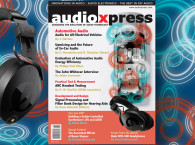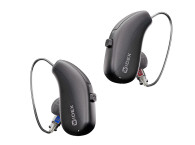
Modern hearing aids are marvels of digital audio processing. They take analog sound waves, convert them to digital signals, process them in various ways to overcome a wearer’s particular form of hearing loss, then convert them back into sound waves played through the hearing aid’s earpiece. Of course, digital audio processing is nothing new, but when it’s performed in hearing aids, it’s meant to have a demonstrable impact on wearers’ lives. Therefore, doing it well is important.
By 2050, the World Health Organization estimates nearly one in four people globally will experience some form of hearing loss. About 700 million of them will need to take corrective action. Among other risks, research indicates that hearing loss can lead to social isolation, and studies from around the world show that social isolation can damage cognitive function. But it’s important to understand that for many, the challenge isn’t just about hearing more (volume); it’s about hearing better (clarity). It’s about picking up the voices of friends and family in a noisy restaurant, for example, or understanding clearly and naturally the words people say. And sometimes, hearing aid technology actually hinders that clarity.
That’s because signal processing in hearing aids takes time — about 5 to 8 milliseconds. This delay in processed audio, when coupled with direct, immediate sound that comes through a hearing aid’s venting, degrades sound quality for the wearer. Known as the comb filter effect, this mixing of processed and direct sound in the ear canal can cause distortion, “tinniness,” and general discomfort when listening over time.
This is where advances in signal processing come into play — and where the choice of signal processing technique can positively impact the natural sound experience for hearing aid wearers. The goal is to minimize delay and quash the comb filter effect, resulting in more natural sound and better hearing. Through a combination of high sampling rate and time-domain filter banks, this natural sound in hearing aids is achievable.
Nuances of Signal Processing in Hearing Aids
Overall, the processing pathway in digital hearing aids is similar across solutions. A microphone picks up the sound and converts it from analog to digital. An analysis filter bank splits the signal into multiple frequency bands, or channels, readying them for further digital signal processing, such as compression and noise reduction. After processing, the signal is recombined by a synthesis filter bank and played out through the receiver in the hearing aid.
This common approach to hearing aid design illustrates the important role of filter banks in digital signal processing. Choosing the right filter bank, which we will discuss in a moment, is key. Also important is the role of sampling, the process of converting the continuous analog sound signal into discrete parts (samples) for processing. As is well known, CDs and many music streaming services use a sampling rate of 44.1kHz (44,100 samples per second). For hearing aids, audio sampling rates typically range between 20kHz and 33.1kHz.
Of course, sampling rate is related to the frequency that can be represented in the signal, so that the highest frequency that can be represented is half the sampling rate (the Nyquist frequency). This means that in hearing aids, a 20kHz sampling rate has a Nyquist frequency of 10kHz, allowing frequencies up to 10kHz, while a 33kHz sampling rate allows frequencies up to 16.5kHz.
These are sampling rates at the input stage; later in the processing pathway, the signal may be down-sampled to save processing capacity, before being up-sampled again. Although other factors, such as receiver roll-off, may limit the frequency range of the output, higher fidelity in the high frequencies is essential for addressing certain forms of hearing loss. Therefore, a higher sampling rate has the best chance of creating that natural sound experience. It can also offer other sound quality benefits, including lower processing delay and more gently sloping filters.
Choosing a Filter Bank
As mentioned earlier, perhaps the most impactful design decision in hearing aids is which type of filter bank to use. Frequency-domain filter banks are popular in hearing aids, often for good reason. But when it comes to creating more natural sound, reducing processing delay, and delivering better hearing, time-domain filter banks are the superior choice.
The difference between the two has to do with a trade-off in processing between time and frequency resolution. In any filter bank, the time resolution of each frequency band is proportional to the width of that frequency band. Broadly speaking, this means that a bandwidth that is five times wider has a time resolution that is five times higher. Conversely, a narrower bandwidth means poorer time resolution.
Frequency-domain filter banks limit the system to frequency bands of the same width across the entire frequency range. In practice, this means that all bands are relatively narrow because bandwidth is set based on the bandwidth needed for the lowest frequencies, where the ear’s frequency sensitivity is the highest, and the bands therefore must be narrow. Because of the trade-off between time and frequency, this also means that all bands—both high- and low-frequency—operate with the same, relatively poor, time resolution.
On the other hand, time-domain filter banks offer the flexibility to use filters that may vary in bandwidth. This means hearing aid designers can set bandwidths any way they like. With a frequency-domain filter bank, all bands have the same width and time resolution, but with a time-domain filter bank, the bands can vary in width and, therefore, also in time resolution. This is important when it comes to a hearing aid use case.
Mimicking How People Hear
What does it mean in practice? With a time-domain filter bank, hearing aid designers can make a filter bank with narrower bands at the lower frequencies and broader bands at the higher frequencies, thus keeping the same trade-off between time and frequency in the filter bank as humans have in their auditory systems. This filter bank design mimics the logarithmic way the ear works, with higher frequency sensitivity at lower frequencies and lower sensitivity at higher frequencies.
Admittedly, frequency-domain filter banks can ostensibly mimic the logarithmic way the ear works by collapsing bands at the higher frequencies and reducing the number of bands overall. But that doesn’t address challenges of time resolution, which can impact speech intelligibility.
When we look at a speech spectrogram (Figure 1), we can visualize the challenge. Spoken consonants are short in duration, but high and wide in frequency. Spoken vowels are longer in duration but lower and narrower in frequency. This means the signal would be best represented by filters where the high frequencies have high time resolution while the low frequencies have better frequency resolution—something better achieved using time-domain filter banks.

Avoiding Down-Sampling for Better Sound Quality
One more thing to consider about filter bank design in hearing aids is the role of down-sampling. For wearers, hearing aids are vital lifestyle devices. Ideally, they last a long time before needing to be recharged, which means power-consuming functions like signal processing need to be optimized. Down-sampling can help accomplish this, but it can also introduce annoying noise artifacts.
Frequency-domain filter banks with narrow filters make down-sampling straightforward, and fewer samples mean less power consumption. With a time-domain filter bank, the benefits of down-sampling are minor and don’t outweigh the risk of artifacts that are inherent to non-linear processes like down- and up-sampling. Yes, a time-domain filter bank means we need other available solutions for keeping power consumption sufficiently low, but by avoiding down-sampling and preserving the original input signal, we achieve higher fidelity, reduce the risk of artifacts, and improve natural sound quality.
Indeed, choosing a time-domain filter bank can make it more challenging to optimize power consumption and certain other aspects of signal processing—though both are very achievable. But ultimately, a time-domain filter bank better complements the human auditory system and helps optimize sound quality. Combined with a high sampling rate, which significantly reduces artifacts in the signal that would otherwise need to be fixed, processing delay can be driven down close to about 2.5 milliseconds, virtually eliminating its effect on hearing.
In other words, when it comes to signal processing in hearing aids, choosing frequency-domain filter banks may be best for the hearing aid manufacturer. But a time-domain filter bank is best for the person the hearing aid is designed to help.
This article was originally published in audioXpress, June 2022.
 About the Author
About the AuthorDana Helmink is Senior Director, Audiology/Clinical Education at Widex USA. She earned her Master of Arts in Audiology from Northern Illinois University and her Doctor of Audiology degree from Salus University. She previously worked in clinical audiology in Illinois, where she also served more than 10 years on the Illinois Academy of Audiology board of directors. With more than 15 years in product management, Dana applies her experience in user-centered design and usability testing to develop innovative training programs.






